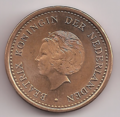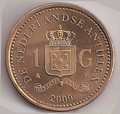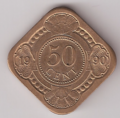Netherlands Antillean guilder
| |||||
|---|---|---|---|---|---|
| |||||
| ISO 4217 | |||||
| Code | ANG | ||||
| Unit | |||||
| Plural | guilders | ||||
| Symbol | NAƒ, NAf, ƒ or f | ||||
| Denominations | |||||
| Subunit | |||||
| 1⁄100 | cent | ||||
| Plural | |||||
| cent | cents | ||||
| Banknotes | |||||
| Freq. used | ƒ10, ƒ25, ƒ50, ƒ100 | ||||
| Coins | 1, 5, 10, 25, 50 cent, ƒ1, ƒ2+1⁄2, ƒ5 | ||||
| Demographics | |||||
| Date of withdrawal | 30 June 2025 | ||||
| Replaced by | Caribbean guilder United States dollar | ||||
| User(s) |
| ||||
| Issuance | |||||
| Central bank | Central Bank of Curaçao and Sint Maarten | ||||
| Website | www | ||||
| Printer | Joh. Enschedé | ||||
| Website | www | ||||
| Mint | Royal Dutch Mint | ||||
| Website | www | ||||
| Valuation | |||||
| Inflation | 3.6% | ||||
| Source | Bank van de Nederlandse Antillen, 2006 Q1 | ||||
| Method | CPI | ||||
| Pegged with | U.S. dollar = ƒ1.79 | ||||
| This infobox shows the latest status before this currency was rendered obsolete. | |||||
The Netherlands Antillean guilder (
In Curaçao and Sint Maarten, a new currency, the Caribbean guilder, was proposed in November 2020.[1][2] Originally planned for implementation in the first half of 2021,[3] It had been stalled repeatedly by negotiations over the establishment of a separate central bank for Curaçao.[4] The new guilder was eventually launched on 31 March 2025.[5] The Netherlands Antillean guilders remained legal tender until 30 June 2025, then the currency was officially withdrawn.
Naming
In
History
In the 18th century, the Dutch guilder circulated in the Netherlands Antilles. This was supplemented in 1794 by an issue of coins specific for the Dutch holdings in the West Indies. At this time, the guilder was subdivided into 20 stuiver.
Between 1799 and 1828, the
In 1940, following the German occupation of the Netherlands, the link to the Dutch currency was broken, with a peg to the U.S. dollar of 1.88585 guilders = 1 dollar established. The peg was adjusted to 1.79 guilders = 1 dollar in 1971.
In 1986, Aruba gained a status aparte and left the Netherlands Antilles. Shortly after that, Aruba began to issue its own currency, the Aruban florin, which replaced the Netherlands Antillean guilder at par.
In 2011, a year after the
Curaçao and Sint Maarten intended to replace their currency, ceasing all production of the Antillean guilder. After Delay's, the old banknotes and coins now also required replacement,[7] and only two years worth of Antilles guilder physical currency was remaining for use. In 2018 there was talk that the islands could opt for the euro or possibly the US dollar in lieu of implementing their own new currency.[8]
In November 2019, Curaçao Finance Minister Kenneth Gijsbertha confirmed the introduction of the Caribbean guilder,[9] and the Central Bank announced the same a year later.[3]
By August 2021, it was reported that the new guilder was expected to launch in either 2023 or 2024.[10] In September 2022, however, CBCS announced an introduction date of 2024.[11] Then in July 2023, its release was postponed to 2025 at the latest.[12] Indeed, the new guilder was introduced on 31 March 2025. After the introduction of the Caribbean guilder, the Netherlands Antillean guilder remained legal tender until 30 June 2025.[5]
Coins

In 1794, silver coins were issued for use in the Dutch West Indies in denominations of 2 stuiver, 1⁄4, 1, and 3 guilders. The Dutch guilder was reintroduced in 1828, and some 1 guilder coins were cut into quarters and stamped with a "C" in 1838 to produce 1⁄4-guilder coins.
In 1900 and 1901, silver 1⁄10 and 1⁄4-guilder coins were introduced, which circulated alongside Dutch coins. Following the German occupation of the Netherlands and the separation of the Netherlands Antillean currency from the Dutch, a bronze 1-cent coin was introduced in 1942, followed by a cupro-nickel 5-cent coin in 1943. Bronze 2+1⁄2 cent and silver 1 and 2+1⁄2 guilders were introduced in 1944. The coinage of 1941–44 was minted in the United States and carried "P" or "D"
From 1952, the name "Nederlandse Antillen" appeared on the coins. In 1970, nickel replaced silver, although the 2+1⁄2-guilder coin was not reintroduced until 1978. Aluminium 1 and 2+1⁄2 cents were introduced in 1979. In 1989, aluminium 1 and 5 cents, nickel-bonded-steel 10 and 25 cents, and aureate-steel 50 cents, 1 and 2+1⁄2 guilders were introduced. Aureate-steel 5-guilder coins followed in 1998.

|

|
The five-guilder coin was produced from aureate steel. The spots on the obverse are the result of corrosion, and are not a typical feature of the coin. Octagonal ridges were built into the face to help distinguish it from the similar one-guilder coin. The obverse featured Beatrix of the Netherlands, while the reverse had the coat of arms of the Netherlands Antilles. |

|

|
The one-guilder coin was produced from aureate steel. The obverse featured Beatrix of the Netherlands, while the reverse has the coat of arms of the Netherlands Antilles. |

|

|
The 50-cent coin was diamond-shaped. It was the only modern Antillean coin in this form, but an earlier version of the five-cent piece was also in this shape. |
Gallery of coins
-
1 cent
-
5 cent (stuiver)
-
10 cent (dubbeltje)
-
25 cent (kwartje)
-
50 cent
-
1 gulden
-
2½ gulden (rijksdaalder)
-
5 gulden
Banknotes
In 1892, the Curaçaosche Bank introduced notes in denominations of 25 and 50 cents, 1 and 2+1⁄2 guilders. This was the only issue of the cent denominations. Notes for 5, 10, 25, 50, 100, 250 and 500 guilders followed in 1900. The 1 and 2+1⁄2 guilder notes were suspended after 1920 but reintroduced by the government in 1942 as muntbiljet.
From 1954, the name "Nederlandse Antillen" appeared on the reverse of the notes of the Curaçaosche Bank and, from 1955, the muntbiljet (2+1⁄2 guilders only) was issued in the name of the Nederlandse Antillen. In 1962, the bank's name was changed to the Bank van de Nederlandse Antillen. Starting in 1969, notes dated 28 AUGUSTUS 1967 began to be introduced. The front of these notes all featured the Statuut monument at front left instead of the allegorical seated woman found on the preceding issues, and on the back there was a new coat of arms.[13] In 1970, a final issue of muntbiljet was made in denominations of both 1 and 2+1⁄2 guilders. The 500 guilder note was not issued after 1962. The 5 and the 250 guilder notes were not issued after 1998. The 5 guilder was replaced with a coin.
| Image | Notes |
|---|---|
 |
The 10 guilder note was illustrated with a hummingbird. Security features included a surface foil tag, an embedded hologram under the hummingbird, and an orange moiré pattern contrasting with the green note. |
 |
The 25 guilder note was illustrated with a Caribbean flamingo. Security features included a surface foil tag, an embedded hologram under the flamingo, and a green moiré pattern contrasting with the pink note. |
 |
The 50 guilder note had an rufous-collared sparrow on the face. Security features included a surface foil tag, an embedded hologram under the sparrow, and a green moiré pattern contrasting with the orange note. |
 |
The 100 guilder note had a bananaquit on the face. Security features included a surface foil tag, an embedded hologram under the bananaquit, and a green moiré pattern contrasting with the brown note. |
| Current ANG exchange rates | |
|---|---|
| From Google Finance: | AUD CAD CHF CNY EUR GBP HKD JPY USD EUR JPY USD |
| From Yahoo! Finance :
|
AUD CAD CHF CNY EUR GBP HKD JPY USD EUR JPY USD |
| From XE.com: | AUD CAD CHF CNY EUR GBP HKD JPY USD EUR JPY USD |
| From OANDA: | AUD CAD CHF CNY EUR GBP HKD JPY USD EUR JPY USD |
See also
Notes
- ^ a b (in Dutch) Rijksoverheid.nl – Wat is er veranderd sinds de staatkundige herindeling van het Koninkrijk der Nederlanden? Archived 20 March 2012 at the Wayback Machine
- ^ "Antilliaanse gulden wordt aangehouden in 2012". dushi-curacao.info (in Dutch). 14 September 2011. Retrieved 28 September 2011.
- ^ a b "Central Bank announces introduction of Caribbean Guilder in 2021". StMaartenNews.com. 15 November 2020. Retrieved 8 December 2020.
- ^ "Jardim: Research Monetary Union Is Not A Priority". Curaçao Chronicle. 15 July 2015. Retrieved 31 December 2015.
- ^ a b "Frequently Asked Questions". Willemstad: Central Bank of Curaçao and Sint Maarten. Retrieved 30 June 2024.
- ISBN 99904-0-030-X
- ^ "Banknotes and coins should soon be replaced". Curaçao Chronicle. 15 February 2016.
- ^ "Only two years worth of Antillean guilders left". The Daily Herald. 13 June 2018. Archived 19 October 2019 at the Wayback Machine
- ^ "Caribbean guilder becomes reality". Curaçao Chronicle. 14 November 2019. Retrieved 8 December 2020.
- ^ "Doornbosch: 'Curaçao economy for 80 percent of foreign exchange reserves and Sint Maarten 20 percent'". Curaçao Chronicle. 17 August 2021. Retrieved 10 October 2021.
- ^ "CBCS moves ahead with the Introduction of the Caribbean Guilder" (PDF). Central Bank of Curaçao and Sint Maarten (Press release). 5 September 2022.
- ^ "Introduction of Caribbean Guilder delayed again, possibly pushed to 2025". Curaçao Chronicle. 13 July 2023. Retrieved 20 September 2023.
- ^ Linzmayer, Owen (2012). "Netherlands Antilles". The Banknote Book. San Francisco, CA: www.BanknoteNews.com.
References
- Krause, Chester L.; Clifford Mishler (1978). ISBN 0873410203.
- Krause, Chester L.; Clifford Mishler (1991). ISBN 0873411501.
- Pick, Albert (1994). Bruce, Colin R. II; Shafer, Neil (eds.). ISBN 0-87341-207-9.
External links
 Media related to Money of the Netherlands Antilles at Wikimedia Commons
Media related to Money of the Netherlands Antilles at Wikimedia Commons- Banknotes of the Netherlands Antilles
- All banknotes







